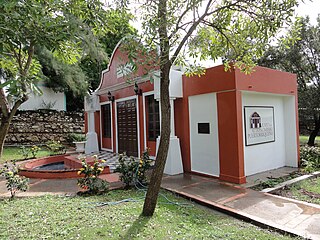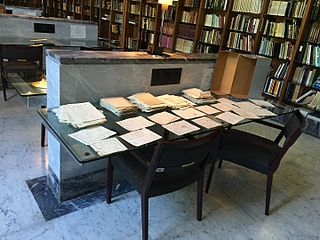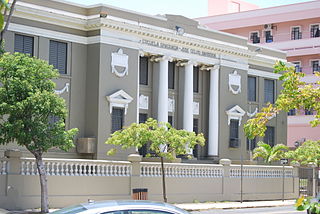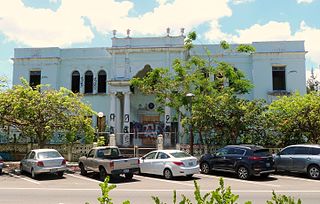
El Nuevo Día is the newspaper with the largest circulation in Puerto Rico. It is considered mainstream and the territory's newspaper of record. It was founded in 1909 in Ponce, Puerto Rico, and today it is a subsidiary of GFR Media. Its headquarters are in Guaynabo, Puerto Rico.

Old San Juan is a historic district located at the "northwest triangle" of the islet of San Juan in San Juan. Its area roughly correlates to the Ballajá, Catedral, Marina, Mercado, San Cristóbal, and San Francisco sub-barrios (sub-districts) of barrio San Juan Antiguo in the municipality of San Juan, Puerto Rico.

Alejandro Tapia y Rivera was a Puerto Rican poet, playwright, essayist and writer. Tapia is considered to be the father of Puerto Rican literature and as the person who has contributed the most to the cultural advancement of Puerto Rico's literature. In addition to his writing, he was also an abolitionist and a women's rights advocate.

Puerta de Tierra is a subbarrio (subdistrict) occupying the eastern portion of the Islet of San Juan and the barrio of San Juan Antiguo in the municipality of San Juan, Puerto Rico. The name Puerta de Tierra derives from the former eastern gated entrance to the walled city of San Juan where Plaza Colón is today. With a population of 2,924 as of 2010, this is the most populated area of San Juan Antiguo. On October 15, 2019, it was added to the National Register of Historic Places.

Caparra is an archaeological site in the municipality of Guaynabo in northeastern Puerto Rico. Declared a U.S. National Historic Landmark in 1994, the site contains the remains of the first European settlement and capital of the main island of Puerto Rico, specifically the foundations of the residence of Juan Ponce de León, the first European conquistador and governor of Puerto Rico. Settled in 1508 and officially abandoned in 1521, it represents the oldest known European settlement in the United States. The site is on the grounds of the Museo de la Conquista y Colonización, which features artifacts from the area and other archaeological sites in Puerto Rico.

Eduardo Neumann Gandía, was one of Puerto Rico's most accomplished historians. He is particularly well known for his nineteenth century book Verdadera y Auténtica Historia de la Ciudad de Ponce: desde sus primitivos tiempos hasta la época contemporánea. His father was Guillermo Neumann, who was mayor of Ponce from 23 April 1851 to 30 September 1851. Eduardo Neumann Gandía's most important work was Benefactores y Hombres Notables de Puerto Rico.. Neumann wrote profusely during a period of 30 years, producing some 20 major works plus numerous articles in newspapers and periodicals.

The Ponce Municipal Library, formally, Biblioteca Municipal Mariana Suárez de Longo, and also known as Biblioteca Publica de Ponce, is the library system of the municipality of Ponce, Puerto Rico. Founded in 1870, it is the oldest public library in Puerto Rico. The system has its main library on Miguel Pou Boulevard, in barrio San Antón, in the city of Ponce, and seven satellite library branches, three in the city's urban area and four spread out in the municipality's rural areas. The main library inaugurated a new building on Bulevar Miguel Pou in August 2007, where the former Puerto Rico District Court building was located. The central library building on Bulevar Miguel Pou was designed by Ponce architect Juan Dalmau Sambolín.

The Museo del Autonomismo Puertorriqueño is a small museum in Ponce, Puerto Rico, that showcases the political history of Puerto Rico with an emphasis on the contributions made by the municipality of Ponce and its residents. The museum was established on 7 September 2006.
The following is a timeline of the history of the municipality of San Juan, Puerto Rico.

The Biblioteca Carnegie on Avenida Juan Ponce de León in Puerta de Tierra, San Juan, Puerto Rico is a NRHP-listed Carnegie library funded through a $100,000 donation from the Carnegie Foundation, becoming Puerto Rico's first purpose-built library when it was completed in 1915.
The following is a timeline of the history of the municipality of Mayagüez, Puerto Rico.

The Archivo General de Puerto Rico, established in 1955, is an archive documenting the history and culture of Puerto Rico. The governmental Institute of Puerto Rican Culture began overseeing its operation in 1956. It is located in a building shared with the national library on Avenida Juan Ponce de León in San Juan. Among its collections is the "Fondo de Obras Publicas", formerly housed in the University of Puerto Rico's archives.
The following is a timeline of the history of the municipality of Bayamón, Puerto Rico.

Segundo Cardona Colom FAIA is a Puerto Rican architect and developer. His work has been recognized by the American Institute of Architects (AIA), by the Colegio de Arquitectos y Arquitectos Paisajistas de Puerto Rico as well as by the International Union of Architects. In 2006 Cardona was elected as Fellow of the American Institute of Architects. In 1992, he was awarded the Henry Klumb Award.
The General Archives of Puerto Rico was formally created by Law 5 of December 8, 1955 and placed under the Institute of Puerto Rican Culture which had been created six months before. The main function of the entity is to safeguard and conserve the most important inactive documents of Puerto Rico's territorial government, both under United States rule as well as during the 390 years of Spanish colonial government in Puerto Rico between 1508 and 1898.

Pollos is a barrio in the municipality of Patillas, Puerto Rico. Its population in 2010 was 3,146.

The Puerta de Tierra Phalanstery, simply known as El Falansterio and originally known as the Puerta de Tierra Tenement Group Project A, is a historic district and Art Deco public housing building complex from 1937 located in the Puerta de Tierra sub-district of San Juan, Puerto Rico.

The José Celso Barbosa Graded School is a historic school building located in the Puerta de Tierra historic district in the city of San Juan, Puerto Rico. The school is named after Puerto Rico statehood movement founder Dr. José Celso Barbosa and has been listed in the National Register of Historic Places since 1989, and on the Puerto Rico Register of Historic Sites and Zones since 2000. The school was built between 1924 and 1927 and designed by the firm del Valle & Co. in a Neoclassical-style with the intention of making it a public secondary school for recently graduated students from the nearby Brambaugh School. It forms part of the monumental sequence of buildings and memorials that contribute to the Puerta de Tierra Historic District, which also includes the Capitol of Puerto Rico.

Templo del Maestro is a historic Beaux Arts building from 1937 that originally served as the seat of the Puerto Rico Teachers Association. The building faces the Luis Muñoz Rivera Park and Supreme Court Building across Juan Ponce de León Avenue in the Puerta de Tierra historic district, a sequence of historically and culturally significant buildings and monuments that includes the Puerto Rico National Library, the Athenaeum and El Capitolio.
















